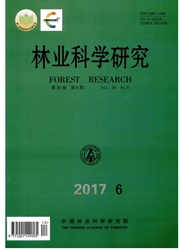

 中文摘要:
中文摘要:
[目的] 沙棘绕实蝇严重危害沙棘果实,使沙棘种植地蒙受巨大经济损失。研究其生物学习性,可以为有效监测和控制沙棘绕实蝇提供理论指导。[方法] 通过室内人工饲养和野外观察,研究沙棘绕实蝇的羽化、交尾、产卵、化蛹等生物学习性和野外发生动态。[结果] 沙棘绕实蝇成虫在野外从6月中旬至8月上旬均可见到,发生量受天气影响较大;成虫主要集中在6:00—10:00羽化,羽化量占当日羽化量的81.3%,羽化高峰出现在8:00—9:00;化蛹时间主要集中在凌晨0:00—6:00,尤其是3:00—6:00钻出果实化蛹的幼虫数量较多,与其它时间段有明显差异;交尾时间主要集中在白天光照比较强的时间段,一天当中有两次交尾高峰,分别出现在12:00—13:00和16:00—17:00,交尾平均持续时长为239±11.86 min;沙棘绕实蝇产卵期沙棘果长径6.65±0.28 mm,宽径5.47±0.40 mm,一果只产一卵。[结论] 沙棘绕实蝇在内蒙古磴口地区一年发生一代,幼虫钻蛀果实,蛹隐藏在地下,成虫期较短,防治工作应集中在成虫期进行。
 英文摘要:
英文摘要:
[Objective] To study the biological characteristics of fruit fly, Rhagoletis batava obseuriosa Kol. (RBO) (Diptera: Tephritidae). [Method] The life cycle and biological characteristics of RBO, including eclosion, mating, oviposition, pupation and population dynamics were studied through laboratory and field observation in Dengkou county, Inner Mongolia. [Result] Adult RBO occurred from the middle June to the early August, and weather could have impact on adult amount. About 81.3% of RBO emerged from 6:00 to 10:00, and the peak time was 8:00 to 9:00. The larvae came out of fruit and pupated mainly in the early morning from 0:00 to 6:00, especially from 3:00 to 6:00. The mating time mainly occurred in the daytime and there were two peaks from 12:00 to 13:00 and 16:00 to 17:00. Usually, the mating lasts 239 ± 11.86 min. The fruit fly preferred to lay one egg into one fruit which the length was 6.65 ± 0.28 mm and the width was 5.47 ± 0.40 mm. The mating and egg-laying behavior of R. batava obseuriosa were studied in details too. [Conclusion] There is only one generation of RBO per year in Dengkou county, Inner Mongolia. The larvae develop within the fruit of Hippophae rhamnoides and pupate in the soil. Though adult period was short, it should be an exact stage for controlling the pest.
 同期刊论文项目
同期刊论文项目
 同项目期刊论文
同项目期刊论文
 期刊信息
期刊信息
